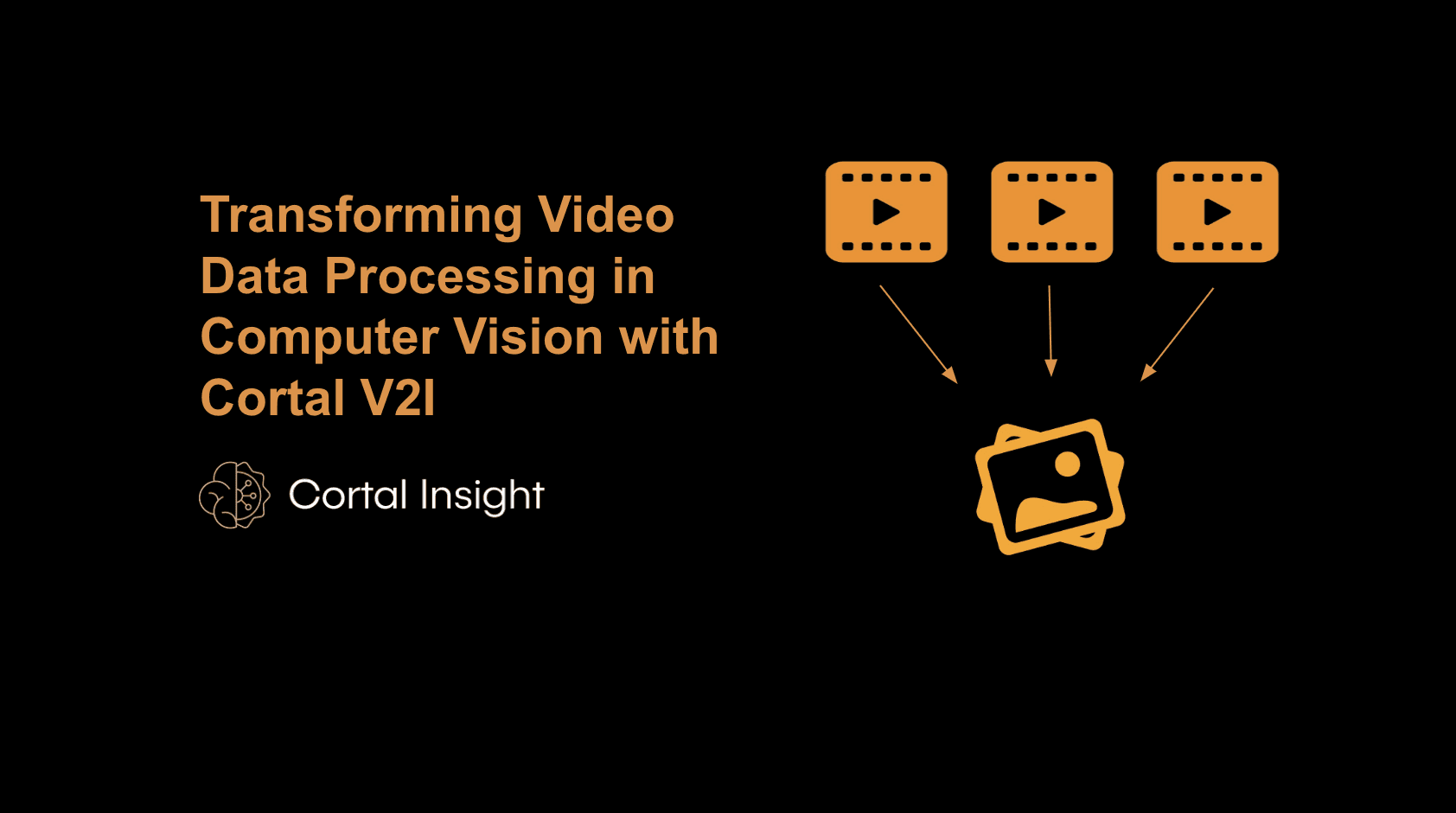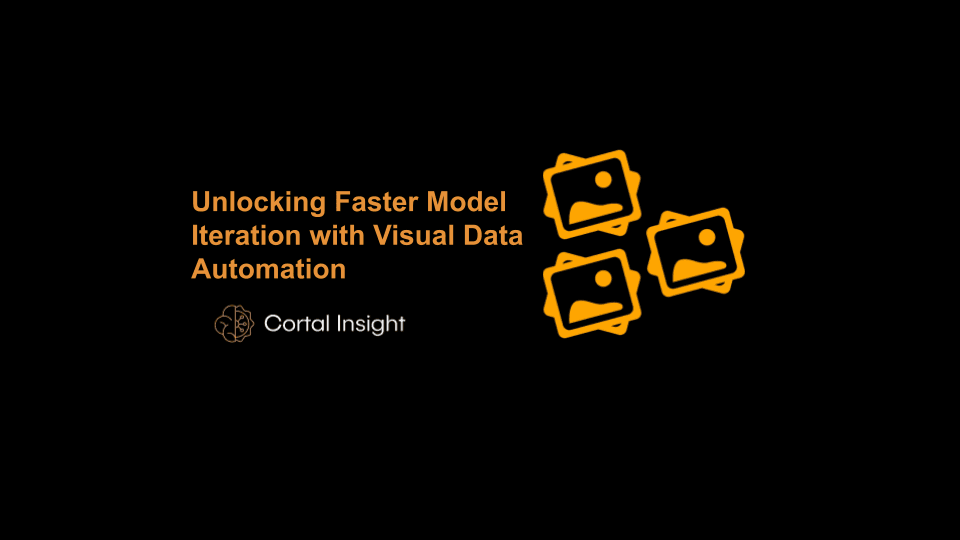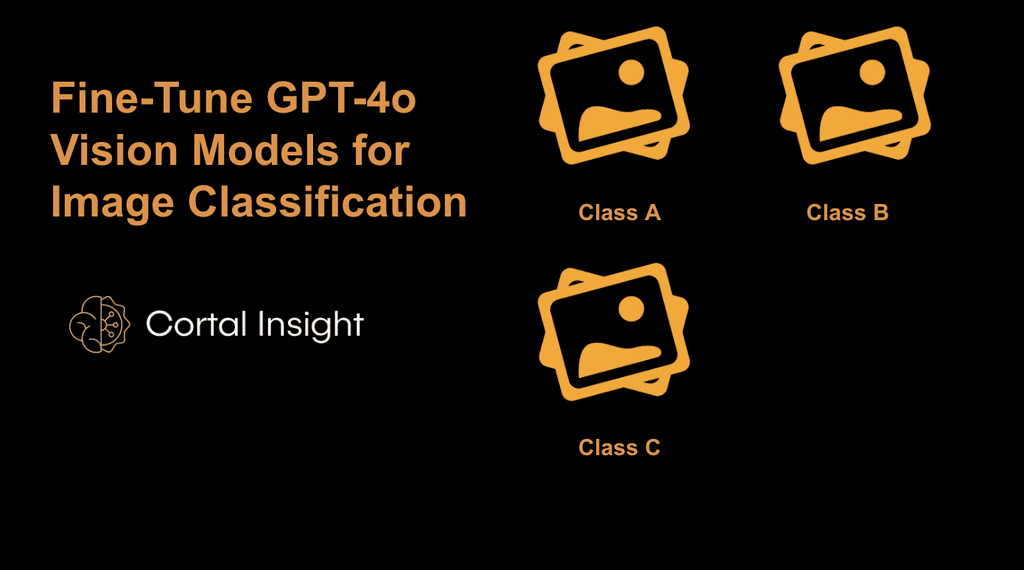Back
Transforming Video Data Processing in Computer Vision with Cortal V2I
Streamline, scale, and simplify Video Data for Machine Learning
Nov 5, 2024


Introduction
In computer vision video data processing is a critical task but it can often be challenging. For machine learning (ML) teams in fields like retail analytics, surveillance, security, compliance, and autonomous robotics, video data holds immense value. But before it can be used to train robust ML models, it must be converted from raw footage into structured data. This process is often complex, time-consuming, and prone to bottlenecks.
That’s where Cortal V2I comes in. Our advanced tool is purpose-built to streamline video data processing in computer vision, automating frame extraction, audio separation, and even large-scale data scraping. With Cortal V2I, you can easily handle massive video libraries, extract frames, pull audio files, and scale processing to hundreds of videos without the need for manual formatting or intervention. Let’s explore how Cortal V2I is designed to empower your ML team and supercharge your video data processing workflows.
How Cortal V2I Simplifies Video Data Processing in Computer Vision
Cortal V2I addresses the key challenges of video data processing in computer vision by providing ML teams with an automated pipeline. Whether you’re analyzing consumer behavior in a retail environment or training autonomous robots, here’s how Cortal V2I can transform your workflow:
Automated Frame Extraction for Large-Scale Datasets
For ML teams in computer vision, extracting frames from video data is often the first (and most tedious) step. With Cortal V2I, this process is automated, allowing you to extract frames at specified intervals or based on custom criteria. This automation saves hours of labor and also ensures your frames are ready for direct use in model training so you can accelerate your video data processing pipeline.Seamless Video Scraping and Data Integration
When your computer vision project requires large amounts of data from sources like YouTube or proprietary databases, gathering and formatting this data can become a bottleneck. Cortal V2I simplifies this by supporting video scraping from multiple platforms, enabling you to quickly pull and structure external video data for analysis. This means less time spent on data collection and more time focused on developing and testing your models.
Integrated Audio Extraction and Metadata Handling
Cortal V2I offers built-in audio extraction for ML projects that analyze multi-modal data. The tool separates audio from video files, creating an additional dataset for comprehensive model training. It also preserves metadata, such as timestamps and origin tags, providing essential context and enhancing data labeling accuracy for your computer vision applications.
Scalable Processing Infrastructure for High-Volume Workloads
Scalability is key in industries where video data is captured around the clock. Cortal V2I is designed to handle hundreds of videos and gigabytes of data efficiently, ensuring consistent performance even as your data needs expand. Cortal V2I’s scalable infrastructure supports high-volume video data processing in computer vision, enabling faster and more reliable workflows in industries like real-time surveillance, compliance audits, or advanced robotics.
Real-World Applications of Video Data Processing in Computer Vision with Cortal V2I
Cortal V2I is designed to streamline video data preparation, making it easier for ML teams across industries to focus on building and refining their models. Here’s how it’s being leveraged in various sectors:
Retail Analytics: ML teams use Cortal V2I to efficiently process in-store video feeds, extracting data to train models that can analyze and generate customer behavior insights.
Surveillance and Security: By automating frame extraction, Cortal V2I helps security teams manage large volumes of footage, supporting quicker anomaly detection workflows
Compliance Audits: Legal and compliance teams benefit from automated video processing, enabling efficient review of footage for audits and regulatory checks
Autonomous Robotics: Robotics teams rely on Cortal V2I to extract and organize video frames, speeding up model training for navigation and decision-making tasks
Quick start guide: Cortal V2I
1. Clone the Repository
To begin, clone the Cortal V2I repository from GitHub:
git clone https://github.com/cortal-insight/cortalinsight-example-workflows.gitNavigate to the project directory:
cd cortalinsight-example-workflows/cortalv2iCreate a virtual environment for this project:
pyenv virtualenv 3.x.x test-env
pyenv activate test-envInstall the required dependencies:
pip install -r requirements.txt2. Using the VideoProcessor Class
For Python users, Cortal V2I offers a simple interface via the VideoProcessor class. Here’s how you can extract frames and audio from a video file:
Import and Initialize the Processor:
from cortalv2i.core.video_processor import VideoProcessor
processor = VideoProcessor(
frames_dir="output/frames",
audio_dir="output/audio"
)Set configuration for processing:
# Frame extraction configuration
frame_config = {
"method": "fps", # Extract frames based on frames per second
"params": {"fps": 1}, # Extract 1 frame per second
"output_format": "jpg", # Save frames as JPG
"resolution": "640*480" # Resize frames to 640x480 resolution (optional)
}
# Audio extraction configuration
audio_config = {
"format": "mp3", # Extract audio as MP3
"bitrate": "192k" # Set audio bitrate
}Process the Input Video:
# Define progress callback function
def progress_callback(progress):
# Only log progress every 10% increment
if progress_callback.last_logged is None or progress - progress_callback.last_logged >= 0.1:
print(f"Progress: {progress * 100:0.0f}%")
progress_callback.last_logged = progress
progress_callback.last_logged = None
# Process the input video
processor.process_input(
input_source= "input/media.mp4", # Path to the video file
start_frame=0, # Starting frame number
end_frame=300, # Ending frame number (process first 300 frames)
extraction_config=frame_config, # Frame extraction settings
progress_callback=progress_callback # Optional progress callback
)
This script automates frame extraction at 1 frame per second and saves audio in MP3 format.
Advanced Features
Custom Frame Extraction: By FPS, time intervals, or scene changes.
Audio Extraction: Supports MP3, AAC, FLAC.
YouTube Processing: Directly process YouTube videos.
Batch & Parallel Processing: Handle multiple videos efficiently with multi-core support.
Progress Tracking: Monitor task status in real-time.
Cortal V2I adapts to unique workflows with configurable extraction_config and audio_config parameters.
Why Cortal V2I Is Essential for Computer Vision Teams
Cortal V2I empowers ML teams to process video data faster and more accurately than ever. By automating the conversion of video to frame-based datasets, handling audio separation, and supporting data scraping from popular platforms, Cortal V2I enables your team to overcome the most common pain points in video data processing for computer vision. Here are just a few ways Cortal V2I can benefit your team:
Increased Efficiency: Automated frame extraction means your team spends less time on data wrangling and more on refining models.
Scalability: Cortal V2I easily handles hundreds of videos, allowing you to scale video data processing without additional resources.
Multi-Modal Data Support: Cortal V2I’s audio extraction and metadata retention features enable teams to build multi-dimensional models and gain deeper insights.
Easy Integration with Cortal Insight: Cortal V2I fits seamlessly into ML workflows providing a ready-to-use solution for processing raw video data.
Get Started with Cortal V2I for Faster, Smarter Video Data Processing in Computer Vision
Cortal V2I is designed for ML teams ready to overcome the limitations of traditional video data processing methods. Cortal V2I can help you save time, reduce costs, and improve data accuracy.
You can find everything you need to get started in our GitHub repository-setup, code, and documentation.
If your team has specific customization needs, whether it’s around cloud integration or unique workflows - feel free to reach out. We can help tailor Cortal V2I to fit your exact requirements.
Introduction
In computer vision video data processing is a critical task but it can often be challenging. For machine learning (ML) teams in fields like retail analytics, surveillance, security, compliance, and autonomous robotics, video data holds immense value. But before it can be used to train robust ML models, it must be converted from raw footage into structured data. This process is often complex, time-consuming, and prone to bottlenecks.
That’s where Cortal V2I comes in. Our advanced tool is purpose-built to streamline video data processing in computer vision, automating frame extraction, audio separation, and even large-scale data scraping. With Cortal V2I, you can easily handle massive video libraries, extract frames, pull audio files, and scale processing to hundreds of videos without the need for manual formatting or intervention. Let’s explore how Cortal V2I is designed to empower your ML team and supercharge your video data processing workflows.
How Cortal V2I Simplifies Video Data Processing in Computer Vision
Cortal V2I addresses the key challenges of video data processing in computer vision by providing ML teams with an automated pipeline. Whether you’re analyzing consumer behavior in a retail environment or training autonomous robots, here’s how Cortal V2I can transform your workflow:
Automated Frame Extraction for Large-Scale Datasets
For ML teams in computer vision, extracting frames from video data is often the first (and most tedious) step. With Cortal V2I, this process is automated, allowing you to extract frames at specified intervals or based on custom criteria. This automation saves hours of labor and also ensures your frames are ready for direct use in model training so you can accelerate your video data processing pipeline.Seamless Video Scraping and Data Integration
When your computer vision project requires large amounts of data from sources like YouTube or proprietary databases, gathering and formatting this data can become a bottleneck. Cortal V2I simplifies this by supporting video scraping from multiple platforms, enabling you to quickly pull and structure external video data for analysis. This means less time spent on data collection and more time focused on developing and testing your models.
Integrated Audio Extraction and Metadata Handling
Cortal V2I offers built-in audio extraction for ML projects that analyze multi-modal data. The tool separates audio from video files, creating an additional dataset for comprehensive model training. It also preserves metadata, such as timestamps and origin tags, providing essential context and enhancing data labeling accuracy for your computer vision applications.
Scalable Processing Infrastructure for High-Volume Workloads
Scalability is key in industries where video data is captured around the clock. Cortal V2I is designed to handle hundreds of videos and gigabytes of data efficiently, ensuring consistent performance even as your data needs expand. Cortal V2I’s scalable infrastructure supports high-volume video data processing in computer vision, enabling faster and more reliable workflows in industries like real-time surveillance, compliance audits, or advanced robotics.
Real-World Applications of Video Data Processing in Computer Vision with Cortal V2I
Cortal V2I is designed to streamline video data preparation, making it easier for ML teams across industries to focus on building and refining their models. Here’s how it’s being leveraged in various sectors:
Retail Analytics: ML teams use Cortal V2I to efficiently process in-store video feeds, extracting data to train models that can analyze and generate customer behavior insights.
Surveillance and Security: By automating frame extraction, Cortal V2I helps security teams manage large volumes of footage, supporting quicker anomaly detection workflows
Compliance Audits: Legal and compliance teams benefit from automated video processing, enabling efficient review of footage for audits and regulatory checks
Autonomous Robotics: Robotics teams rely on Cortal V2I to extract and organize video frames, speeding up model training for navigation and decision-making tasks
Quick start guide: Cortal V2I
1. Clone the Repository
To begin, clone the Cortal V2I repository from GitHub:
git clone https://github.com/cortal-insight/cortalinsight-example-workflows.gitNavigate to the project directory:
cd cortalinsight-example-workflows/cortalv2iCreate a virtual environment for this project:
pyenv virtualenv 3.x.x test-env
pyenv activate test-envInstall the required dependencies:
pip install -r requirements.txt2. Using the VideoProcessor Class
For Python users, Cortal V2I offers a simple interface via the VideoProcessor class. Here’s how you can extract frames and audio from a video file:
Import and Initialize the Processor:
from cortalv2i.core.video_processor import VideoProcessor
processor = VideoProcessor(
frames_dir="output/frames",
audio_dir="output/audio"
)Set configuration for processing:
# Frame extraction configuration
frame_config = {
"method": "fps", # Extract frames based on frames per second
"params": {"fps": 1}, # Extract 1 frame per second
"output_format": "jpg", # Save frames as JPG
"resolution": "640*480" # Resize frames to 640x480 resolution (optional)
}
# Audio extraction configuration
audio_config = {
"format": "mp3", # Extract audio as MP3
"bitrate": "192k" # Set audio bitrate
}Process the Input Video:
# Define progress callback function
def progress_callback(progress):
# Only log progress every 10% increment
if progress_callback.last_logged is None or progress - progress_callback.last_logged >= 0.1:
print(f"Progress: {progress * 100:0.0f}%")
progress_callback.last_logged = progress
progress_callback.last_logged = None
# Process the input video
processor.process_input(
input_source= "input/media.mp4", # Path to the video file
start_frame=0, # Starting frame number
end_frame=300, # Ending frame number (process first 300 frames)
extraction_config=frame_config, # Frame extraction settings
progress_callback=progress_callback # Optional progress callback
)
This script automates frame extraction at 1 frame per second and saves audio in MP3 format.
Advanced Features
Custom Frame Extraction: By FPS, time intervals, or scene changes.
Audio Extraction: Supports MP3, AAC, FLAC.
YouTube Processing: Directly process YouTube videos.
Batch & Parallel Processing: Handle multiple videos efficiently with multi-core support.
Progress Tracking: Monitor task status in real-time.
Cortal V2I adapts to unique workflows with configurable extraction_config and audio_config parameters.
Why Cortal V2I Is Essential for Computer Vision Teams
Cortal V2I empowers ML teams to process video data faster and more accurately than ever. By automating the conversion of video to frame-based datasets, handling audio separation, and supporting data scraping from popular platforms, Cortal V2I enables your team to overcome the most common pain points in video data processing for computer vision. Here are just a few ways Cortal V2I can benefit your team:
Increased Efficiency: Automated frame extraction means your team spends less time on data wrangling and more on refining models.
Scalability: Cortal V2I easily handles hundreds of videos, allowing you to scale video data processing without additional resources.
Multi-Modal Data Support: Cortal V2I’s audio extraction and metadata retention features enable teams to build multi-dimensional models and gain deeper insights.
Easy Integration with Cortal Insight: Cortal V2I fits seamlessly into ML workflows providing a ready-to-use solution for processing raw video data.
Get Started with Cortal V2I for Faster, Smarter Video Data Processing in Computer Vision
Cortal V2I is designed for ML teams ready to overcome the limitations of traditional video data processing methods. Cortal V2I can help you save time, reduce costs, and improve data accuracy.
You can find everything you need to get started in our GitHub repository-setup, code, and documentation.
If your team has specific customization needs, whether it’s around cloud integration or unique workflows - feel free to reach out. We can help tailor Cortal V2I to fit your exact requirements.
Introduction
In computer vision video data processing is a critical task but it can often be challenging. For machine learning (ML) teams in fields like retail analytics, surveillance, security, compliance, and autonomous robotics, video data holds immense value. But before it can be used to train robust ML models, it must be converted from raw footage into structured data. This process is often complex, time-consuming, and prone to bottlenecks.
That’s where Cortal V2I comes in. Our advanced tool is purpose-built to streamline video data processing in computer vision, automating frame extraction, audio separation, and even large-scale data scraping. With Cortal V2I, you can easily handle massive video libraries, extract frames, pull audio files, and scale processing to hundreds of videos without the need for manual formatting or intervention. Let’s explore how Cortal V2I is designed to empower your ML team and supercharge your video data processing workflows.
How Cortal V2I Simplifies Video Data Processing in Computer Vision
Cortal V2I addresses the key challenges of video data processing in computer vision by providing ML teams with an automated pipeline. Whether you’re analyzing consumer behavior in a retail environment or training autonomous robots, here’s how Cortal V2I can transform your workflow:
Automated Frame Extraction for Large-Scale Datasets
For ML teams in computer vision, extracting frames from video data is often the first (and most tedious) step. With Cortal V2I, this process is automated, allowing you to extract frames at specified intervals or based on custom criteria. This automation saves hours of labor and also ensures your frames are ready for direct use in model training so you can accelerate your video data processing pipeline.Seamless Video Scraping and Data Integration
When your computer vision project requires large amounts of data from sources like YouTube or proprietary databases, gathering and formatting this data can become a bottleneck. Cortal V2I simplifies this by supporting video scraping from multiple platforms, enabling you to quickly pull and structure external video data for analysis. This means less time spent on data collection and more time focused on developing and testing your models.
Integrated Audio Extraction and Metadata Handling
Cortal V2I offers built-in audio extraction for ML projects that analyze multi-modal data. The tool separates audio from video files, creating an additional dataset for comprehensive model training. It also preserves metadata, such as timestamps and origin tags, providing essential context and enhancing data labeling accuracy for your computer vision applications.
Scalable Processing Infrastructure for High-Volume Workloads
Scalability is key in industries where video data is captured around the clock. Cortal V2I is designed to handle hundreds of videos and gigabytes of data efficiently, ensuring consistent performance even as your data needs expand. Cortal V2I’s scalable infrastructure supports high-volume video data processing in computer vision, enabling faster and more reliable workflows in industries like real-time surveillance, compliance audits, or advanced robotics.
Real-World Applications of Video Data Processing in Computer Vision with Cortal V2I
Cortal V2I is designed to streamline video data preparation, making it easier for ML teams across industries to focus on building and refining their models. Here’s how it’s being leveraged in various sectors:
Retail Analytics: ML teams use Cortal V2I to efficiently process in-store video feeds, extracting data to train models that can analyze and generate customer behavior insights.
Surveillance and Security: By automating frame extraction, Cortal V2I helps security teams manage large volumes of footage, supporting quicker anomaly detection workflows
Compliance Audits: Legal and compliance teams benefit from automated video processing, enabling efficient review of footage for audits and regulatory checks
Autonomous Robotics: Robotics teams rely on Cortal V2I to extract and organize video frames, speeding up model training for navigation and decision-making tasks
Quick start guide: Cortal V2I
1. Clone the Repository
To begin, clone the Cortal V2I repository from GitHub:
git clone https://github.com/cortal-insight/cortalinsight-example-workflows.gitNavigate to the project directory:
cd cortalinsight-example-workflows/cortalv2iCreate a virtual environment for this project:
pyenv virtualenv 3.x.x test-env
pyenv activate test-envInstall the required dependencies:
pip install -r requirements.txt2. Using the VideoProcessor Class
For Python users, Cortal V2I offers a simple interface via the VideoProcessor class. Here’s how you can extract frames and audio from a video file:
Import and Initialize the Processor:
from cortalv2i.core.video_processor import VideoProcessor
processor = VideoProcessor(
frames_dir="output/frames",
audio_dir="output/audio"
)Set configuration for processing:
# Frame extraction configuration
frame_config = {
"method": "fps", # Extract frames based on frames per second
"params": {"fps": 1}, # Extract 1 frame per second
"output_format": "jpg", # Save frames as JPG
"resolution": "640*480" # Resize frames to 640x480 resolution (optional)
}
# Audio extraction configuration
audio_config = {
"format": "mp3", # Extract audio as MP3
"bitrate": "192k" # Set audio bitrate
}Process the Input Video:
# Define progress callback function
def progress_callback(progress):
# Only log progress every 10% increment
if progress_callback.last_logged is None or progress - progress_callback.last_logged >= 0.1:
print(f"Progress: {progress * 100:0.0f}%")
progress_callback.last_logged = progress
progress_callback.last_logged = None
# Process the input video
processor.process_input(
input_source= "input/media.mp4", # Path to the video file
start_frame=0, # Starting frame number
end_frame=300, # Ending frame number (process first 300 frames)
extraction_config=frame_config, # Frame extraction settings
progress_callback=progress_callback # Optional progress callback
)
This script automates frame extraction at 1 frame per second and saves audio in MP3 format.
Advanced Features
Custom Frame Extraction: By FPS, time intervals, or scene changes.
Audio Extraction: Supports MP3, AAC, FLAC.
YouTube Processing: Directly process YouTube videos.
Batch & Parallel Processing: Handle multiple videos efficiently with multi-core support.
Progress Tracking: Monitor task status in real-time.
Cortal V2I adapts to unique workflows with configurable extraction_config and audio_config parameters.
Why Cortal V2I Is Essential for Computer Vision Teams
Cortal V2I empowers ML teams to process video data faster and more accurately than ever. By automating the conversion of video to frame-based datasets, handling audio separation, and supporting data scraping from popular platforms, Cortal V2I enables your team to overcome the most common pain points in video data processing for computer vision. Here are just a few ways Cortal V2I can benefit your team:
Increased Efficiency: Automated frame extraction means your team spends less time on data wrangling and more on refining models.
Scalability: Cortal V2I easily handles hundreds of videos, allowing you to scale video data processing without additional resources.
Multi-Modal Data Support: Cortal V2I’s audio extraction and metadata retention features enable teams to build multi-dimensional models and gain deeper insights.
Easy Integration with Cortal Insight: Cortal V2I fits seamlessly into ML workflows providing a ready-to-use solution for processing raw video data.
Get Started with Cortal V2I for Faster, Smarter Video Data Processing in Computer Vision
Cortal V2I is designed for ML teams ready to overcome the limitations of traditional video data processing methods. Cortal V2I can help you save time, reduce costs, and improve data accuracy.
You can find everything you need to get started in our GitHub repository-setup, code, and documentation.
If your team has specific customization needs, whether it’s around cloud integration or unique workflows - feel free to reach out. We can help tailor Cortal V2I to fit your exact requirements.

Durga Chowdary & Kobe Conklin
Other articles you might like
Learn how to increase your productivity with calendars


